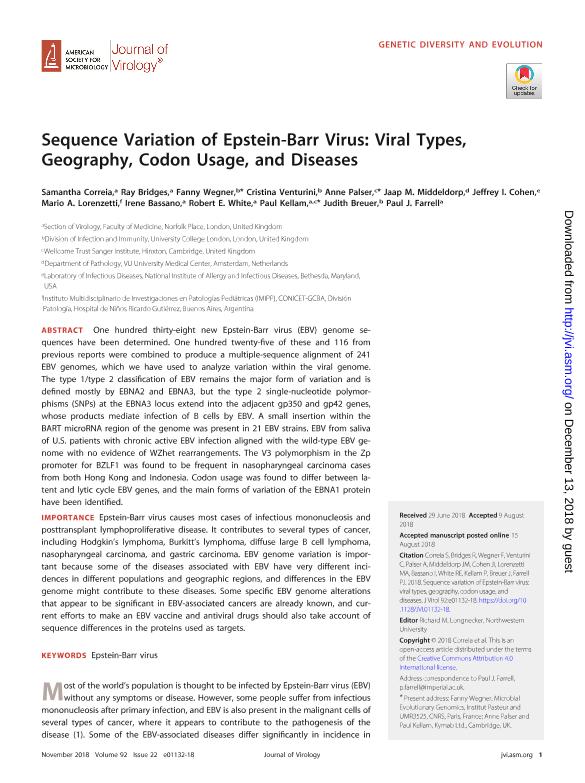Artículo
Sequence variation of Epstein-Barr virus: viral types, geography, codon usage and diseases
Correia, Samantha; Bridges, Ray; Wegner, Fanny; Venturini, Cristina; Palser, Anne; Middeldorp, Jaap M.; Cohen, Jeffrey I.; Lorenzetti, Mario Alejandro ; Bassano, Irene; White, Robert E.; Kellam, Paul; Breuer, Judith; Farrell, Paul J.
; Bassano, Irene; White, Robert E.; Kellam, Paul; Breuer, Judith; Farrell, Paul J.
 ; Bassano, Irene; White, Robert E.; Kellam, Paul; Breuer, Judith; Farrell, Paul J.
; Bassano, Irene; White, Robert E.; Kellam, Paul; Breuer, Judith; Farrell, Paul J.
Fecha de publicación:
08/2018
Editorial:
American Society for Microbiology
Revista:
Journal of Virology
ISSN:
0022-538X
Idioma:
Inglés
Tipo de recurso:
Artículo publicado
Clasificación temática:
Resumen
One hundred thirty-eight new Epstein-Barr virus (EBV) genome sequences have been determined. One hundred twenty-five of these and 116 from previous reports were combined to produce a multiple-sequence alignment of 241 EBV genomes, which we have used to analyze variation within the viral genome. The type 1/type 2 classification of EBV remains the major form of variation and is defined mostly by EBNA2 and EBNA3, but the type 2 single-nucleotide polymorphisms (SNPs) at the EBNA3 locus extend into the adjacent gp350 and gp42 genes, whose products mediate infection of B cells by EBV. A small insertion within the BART microRNA region of the genome was present in 21 EBV strains. EBV from saliva of U.S. patients with chronic active EBV infection aligned with the wild-Type EBV genome with no evidence of WZhet rearrangements. The V3 polymorphism in the Zp promoter for BZLF1 was found to be frequent in nasopharyngeal carcinoma cases from both Hong Kong and Indonesia. Codon usage was found to differ between latent and lytic cycle EBV genes, and the main forms of variation of the EBNA1 protein have been identified. IMPORTANCE Epstein-Barr virus causes most cases of infectious mononucleosis and posttransplant lymphoproliferative disease. It contributes to several types of cancer, including Hodgkin's lymphoma, Burkitt's lymphoma, diffuse large B cell lymphoma, nasopharyngeal carcinoma, and gastric carcinoma. EBV genome variation is important because some of the diseases associated with EBV have very different incidences in different populations and geographic regions, and differences in the EBV genome might contribute to these diseases. Some specific EBV genome alterations that appear to be significant in EBV-Associated cancers are already known, and current efforts to make an EBV vaccine and antiviral drugs should also take account of sequence differences in the proteins used as targets.
Palabras clave:
EPSTEIN-BARR VIRUS
Archivos asociados
Licencia
Identificadores
Colecciones
Articulos(IMIPP)
Articulos de INSTITUTO MULTIDISCIPLINARIO DE INVESTIGACIONES EN PATOLOGIAS PEDIATRICAS
Articulos de INSTITUTO MULTIDISCIPLINARIO DE INVESTIGACIONES EN PATOLOGIAS PEDIATRICAS
Citación
Correia, Samantha; Bridges, Ray; Wegner, Fanny; Venturini, Cristina; Palser, Anne; et al.; Sequence variation of Epstein-Barr virus: viral types, geography, codon usage and diseases; American Society for Microbiology; Journal of Virology; 92; 22; 8-2018; 1-15
Compartir
Altmétricas



